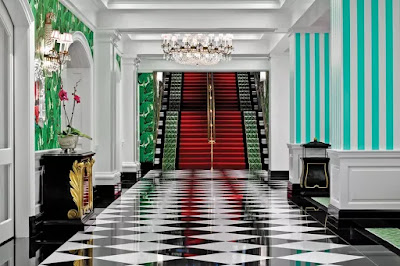Art Nouveau literally means "New Art." This is a decorative style in architecture, interior design, graphics, and furniture that started in France in the late nineteenth century. I learned that because this style started during a time of political turmoil, some years before World War I, it did not last long. However, for the period it was trendy, it spread rapidly across Europe.
A French shop-owner, named Samuel Bing, began this style in 1895. He opened a gallery in Paris called "L'Art Nouveau," which featured art of the new era. During the period, publicity was through international exhibitions. During Samuel Bing's exhibition, artists and designers from different countries came to see the current trends that were being featured. Very quickly, Art Nouveau also became famous in Belgium, Italy, and Spain.
The architecture, interiors, jewelry, furniture, graphics, etc., of Art Nouveau are characterized by very curvilinear forms, using organic motifs of insects, flora and fauna. This is because the style is based off natural elements, and the curvier female form is also a basis. There is emphasis on unity of all elements of the interior; harmony between the walls, floor, furniture and decorations.
I find it interesting that both the Arts and Crafts Movement and Art Noveau were movements in rejection of the Victorian design, but they have significant differences. Art Nouveau followed the lead of William Morris and other Arts and Crafts designers and thinkers, but went a different way with it. They took different approaches in their consideration of historical precedents; in the materials used; and in the technology used for design. Arts and Crafts did not acknowledge historical precedents, where as Art Nouveau paid attention to historical examples. [*Edited* It was later clarified to me that both Art Nouveau and the Arts and Crafts Movement did not use historical precedents.] The furniture and decorative arts in the Arts and Crafts Movement used oak wood; whereas Art Nouveau used richer materials, such as walnut, mahogany, and rosewood, and even rare exotic materials for detailing furniture. The Arts and Crafts Movement stressed handcrafted furniture, whereas Art Nouveau embraced the newly evolving industrial manufacturing process.
I like how Art Nouveau makes use of the industrial manufacturing process in a positive way, unlike how it was used in Victorian design. Instead of totally ignoring it, like the Arts and Crafts, they figured out how to work with it and still have creative, artistic designs. This is important to me because as a designer, I need to figure out how to cooperate with new and evolving technology, without compromising good design.
Historical Examples
 |
| Italian Art Nouveau Two-tier table, c. 1900 |
 |
Facade of Casa Batllo, Barcelona 1904
Designed by Antoni Gaudi |
 |
Art Nouveau Staircase (1993-7) Emile Tassel House, Brussels
Designed by Victor Horta. |
Current Applications:
 |
| Modern Art Nouveau Interior |
 |
| Staircase in River Oaks Townhouse |
 |
| Pair of Sculptural Leaf Motif Armchairs/Side Chairs |
One Step Further...
Victor Horta was born in Ghent, Belgium in 1861. Long with
Henry van de Velde and Paul Hankar, he was a pionner of modern Belgian
architecture, and an outstanding architect of the Art Nouveau style. He studied
architecutre at the Académie des Beaux-Arts in 1873, and then at Athénée Royal
from 1874 to 1877.
Horta moved to Brussels in 1881, and it was there that he
designed his first independent building, the four-story Hôtel Tassel. This
building was among the first Continental examples of Art Nouveau, using curves
on the facade and also in the interior. He designed townhouses for the elite.
Other of his works in the same rich Art Nouveau style include Hôtel Solvay,
Hôtel Winssingers, and Horta's house on the rue Américaine.
His greatest work is the Maison du Peuple. This was the
first building in Belgium to have a large iron and glass facade. The interior
of the auditorium used iron beams that were both decorative and structural.
This building shows how Art Nouveau was an early sign of modernism that spread
across late nineteenth-century developments.
Some of his works:
 |
Interior of Hôtel Solvay, Ixelles, Belgium 1900
|
 |
Facade of Hôtel Solvay, Ixelles, Belgium 1900
|
 |
| Facade of Hôtel Tassel, Brussels, Belgium 1894 |












Very good summary Eunice! The distinctions and similarities between the two different movements ( Arts and Crafts and Art Nouveau) were very well put, especially when it comes to historical precedents. However, both movements rejected historicism.
ReplyDeleteEunice,
ReplyDeleteI appreciate your summary of the Art Nouveau movement. Designers, artists and furniture makers focused on nature as a source of inspiration for their design. Neither Arts and Crafts or Art Nouveau were inspired by historical precedent.
I agree with you that making use of the industrial manufacturing process was a strength of this movement.
Taking a closer look at Victor Horta was an excellent idea. He was the single mas important designer in the Art Nouveau movement. The Hotel Tassel is one of my favorites too!
As you mentioned, this design movement was a precursor to modernism. Horta developed the curtain wall, which is one example of the beginning of Modernism.
You gave many great visual examples of furniture, interiors and architecture from this period.
Eunice,
ReplyDeleteYour summary was very inclusive of the main points and concepts of Art Nouveau. I especially agree with your statement that Arts and Crafts is similar to Art Nouveau however, they are also vastly different. I loved seeing your current applications because they perfectly convey traits of Art Nouveau, especially with the highly ornamented staircases. I also enjoy Victor Horta's work even though I sometimes find Art Nouveau a bit overpowering, but he is very tasteful.